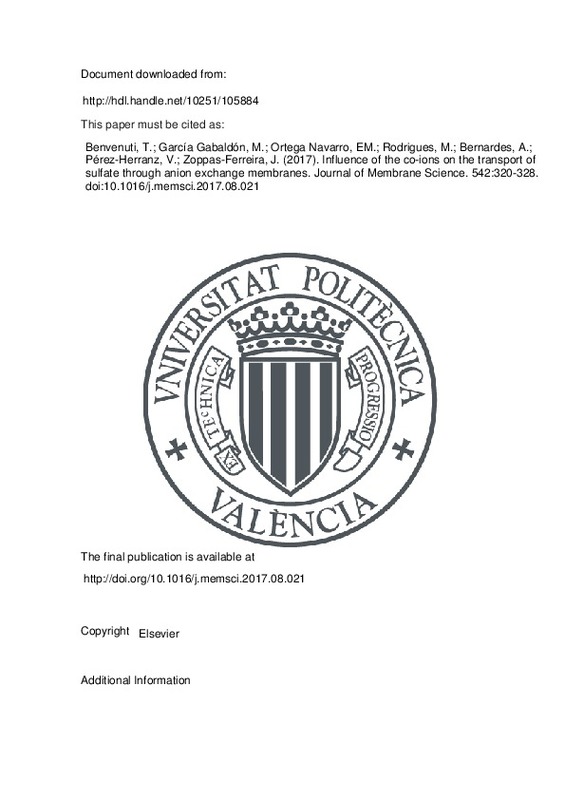JavaScript is disabled for your browser. Some features of this site may not work without it.
Buscar en RiuNet
Listar
Mi cuenta
Estadísticas
Ayuda RiuNet
Admin. UPV
Influence of the co-ions on the transport of sulfate through anion exchange membranes
Mostrar el registro sencillo del ítem
Ficheros en el ítem
| dc.contributor.author | Benvenuti, T.
|
es_ES |
| dc.contributor.author | García Gabaldón, Montserrat
|
es_ES |
| dc.contributor.author | Ortega Navarro, Emma María
|
es_ES |
| dc.contributor.author | Rodrigues, M.A.S.
|
es_ES |
| dc.contributor.author | Bernardes, A.M.
|
es_ES |
| dc.contributor.author | Pérez-Herranz, Valentín
|
es_ES |
| dc.contributor.author | Zoppas-Ferreira, J.
|
es_ES |
| dc.date.accessioned | 2018-07-16T07:38:55Z | |
| dc.date.available | 2018-07-16T07:38:55Z | |
| dc.date.issued | 2017 | es_ES |
| dc.identifier.issn | 0376-7388 | es_ES |
| dc.identifier.uri | http://hdl.handle.net/10251/105884 | |
| dc.description.abstract | [EN] The increasing demand for clean industrial processes has intensified the use of electrodialysis (ED) in the treatment of metal containing effluents from plating processes. Nickel rinsewater is a multicomponent solution that can be treated by ED in order to recover chemicals and reuse water. The investigation of the different phenomena involved in the transport of anions through anion-exchange membranes in this wastewater has been performed in different synthetic solutions by chronopotentiometry. Parameters like the limiting current density (i(lim)), the plateau length (Delta U-m), the resistance of the ohmic region (R-ohm) and the resistance of the overlimiting region (R-3) were also determined. Even though an anion exchange membrane (AEM), the limiting current density was affected by the proton leakage phenomena, indicated that the proton H+ has a greater effect than the other co-ions (Ni2+, Mg2+ and Na+). Ohmic resistances were reduced and plateau lengths were increased in the presence of protons. For salts solutions (without acid) the highest diffusion coefficients and lowest co-ion hydrated radii gave the highest plateau lengths and i(lim), but the lowest R-ohm. | es_ES |
| dc.description.sponsorship | This study was financially supported by Erasmus Brazilian Windows Plus (EBW+), CAPES, CNPq, BNDES, FINEP, SCIT and FAPERGS. | |
| dc.language | Inglés | es_ES |
| dc.publisher | Elsevier | es_ES |
| dc.relation.ispartof | Journal of Membrane Science | es_ES |
| dc.rights | Reconocimiento - No comercial - Sin obra derivada (by-nc-nd) | es_ES |
| dc.subject | Anion-exchange membrane | es_ES |
| dc.subject | Sulfate anion transport | es_ES |
| dc.subject | Proton leakage | es_ES |
| dc.subject | Co-ion effect | es_ES |
| dc.subject.classification | INGENIERIA QUIMICA | es_ES |
| dc.title | Influence of the co-ions on the transport of sulfate through anion exchange membranes | es_ES |
| dc.type | Artículo | es_ES |
| dc.identifier.doi | 10.1016/j.memsci.2017.08.021 | es_ES |
| dc.rights.accessRights | Abierto | es_ES |
| dc.contributor.affiliation | Universitat Politècnica de València. Departamento de Ingeniería Química y Nuclear - Departament d'Enginyeria Química i Nuclear | es_ES |
| dc.description.bibliographicCitation | Benvenuti, T.; García Gabaldón, M.; Ortega Navarro, EM.; Rodrigues, M.; Bernardes, A.; Pérez-Herranz, V.; Zoppas-Ferreira, J. (2017). Influence of the co-ions on the transport of sulfate through anion exchange membranes. Journal of Membrane Science. 542:320-328. doi:10.1016/j.memsci.2017.08.021 | es_ES |
| dc.description.accrualMethod | S | es_ES |
| dc.relation.publisherversion | http://doi.org/10.1016/j.memsci.2017.08.021 | es_ES |
| dc.description.upvformatpinicio | 320 | es_ES |
| dc.description.upvformatpfin | 328 | es_ES |
| dc.type.version | info:eu-repo/semantics/publishedVersion | es_ES |
| dc.description.volume | 542 | es_ES |
| dc.relation.pasarela | S\342045 | es_ES |
| dc.contributor.funder | European Commission | |
| dc.contributor.funder | Coordenaçao de Aperfeiçoamento de Pessoal de Nível Superior, Brasil | |
| dc.contributor.funder | Conselho Nacional de Desenvolvimento Científico e Tecnológico, Brasil | |
| dc.contributor.funder | Banco Nacional de Desenvolvimento Econômico e Social, Brasil | |
| dc.contributor.funder | Financiadora de Estudos e Projetos, Brasil | |
| dc.contributor.funder | Fundação de Amparo à Pesquisa do Estado do Rio Grande do Sul |







![[Cerrado]](/themes/UPV/images/candado.png)

